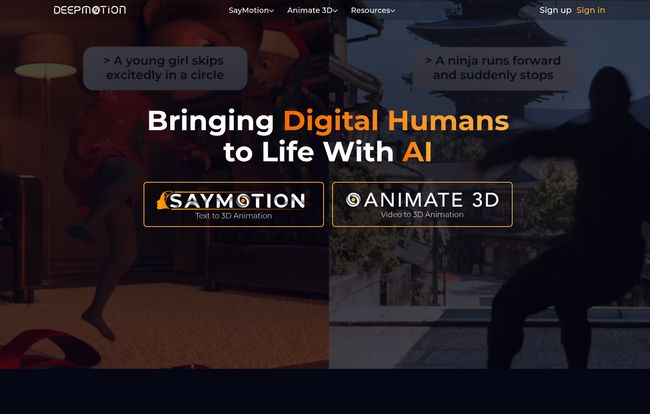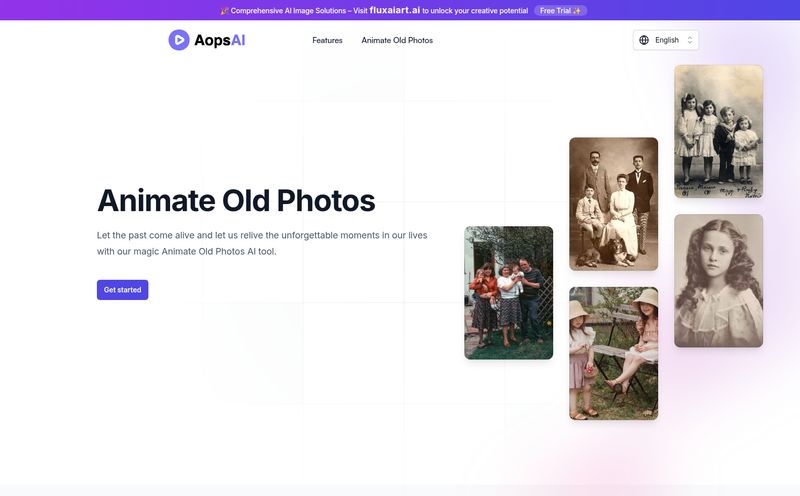I’ve been in the content and traffic generation space for a long, long time. I remember the days when creating a simple animated GIF was a minor miracle. Fast forward to today, and we're living in a full-blown AI gold rush. We've got AI writing articles, painting masterpieces, and now, it's coming for 3D animation. And let me tell you, I've seen a lot of tools that promise the world and deliver a postage stamp. So when I started hearing the buzz around DeepMotion, I was skeptical, but also… incredibly curious.
Could you really just take a video from your phone and get a professional-grade 3D animation? Or—get this—just type a description and have an AI generate the movement for you? It sounds like science fiction. But after spending some time with the platform, I can say it's very, very real. And it might just change things for a lot of creators out there.
So, What is DeepMotion, Really?
At its core, DeepMotion is a cloud-based platform that uses artificial intelligence to create 3D animations. Simple as that. But the magic is in how it does it. It's not one single tool; it's a suite, primarily split into two powerhouse products: Animate 3D and SayMotion.
- Animate 3D is the video-to-animation workhorse. You upload a video of a person moving—dancing, fighting, walking, whatever—and its AI analyzes the motion and maps it onto a 3D character.
- SayMotion is the new kid on the block, and frankly, the one that feels most like the future. It’s a text-to-animation generator. You type in a prompt like "a character stumbles and then waves apologetically," and the AI generates the animation from scratch.
Think of it this way: Animate 3D is for capturing reality, while SayMotion is for creating it from your imagination. Together, they aim to democratize a field that has historically been walled off by high costs, complex software, and years of specialized training.

Visit DeepMotion
Animate 3D: Your iPhone is the New Mocap Suit
Let's talk about Animate 3D first, because it solves a very old problem. Traditional motion capture (mocap) is a pain. It involves expensive suits covered in little reflective balls, a studio full of cameras, and a team of technicians. It's amazing tech, but completely out of reach for indie developers, YouTubers, or small studios. I’ve seen friends try to rig up janky DIY solutions with old gaming console cameras, and the results were… mixed, to put it kindly.
Animate 3D throws all that out the window. The AI does the heavy lifting, tracking the human body from a single video source. No markers, no special suits, no multi-camera setup. Just you, your phone, and an idea. This is a massive deal for anyone needing realistic human motion for games, VR/AR experiences, or even pre-visualization for films. The quality is surprisingly solid, especially for a tool that runs in a web browser. It's not going to replace a high-end Vicon system for a Hollywood blockbuster, but for 90% of creators? It's more than good enough.
SayMotion: Just Type Your Animation into Existence
Okay, now for SayMotion. If Animate 3D is an evolution, SayMotion feels like a revolution. We've all gotten used to text-to-image generators like Midjourney. SayMotion is that, but for movement. It’s built on what DeepMotion calls a "large motion model," trained on a massive library of human actions.
The implications are pretty wild. Stuck on creating a specific idle animation for your game's shopkeeper? Just type "A person stands with their hands on their hips, occasionally shifting their weight." Need a quick sequence for a cutscene? "A hero dodges left, then lunges forward with a sword." It’s an incredible tool for rapid prototyping and brainstorming. Instead of spending hours keyframing a rough draft, you can generate half a dozen variations in minutes. This doesn't just save time; it changes the creative process itself, making it more fluid and experimental.
A Look at the Features That Matter
Beyond the two main products, a few features stood out to me as being particularly important for anyone seriously considering this for their workflow.
AI-Powered Body Tracking and Physics
The core technology is obviously the AI body tracking, and it's impressive. It handles a wide range of motion and even does a decent job with interactions like foot-locking, which keeps the character's feet from sliding around unnaturally. The included Physics Filter adds another layer of realism, ensuring the final animation feels grounded and believable. These aren't just flashy gimmicks; they are functional tools that directly address common animation problems.
Custom Character Integration
This is a big one. Generating cool animations is one thing, but they're not much use if you can't apply them to your character. DeepMotion allows you to upload your own custom 3D models (in standard formats like FBX or VRM) and retarget the animations to your rig. This is the bridge that connects DeepMotion's power to your actual project, whether it's in Unreal Engine, Unity, or Blender. The process is mostly automated and is a crucial part of making this a practical tool rather than just a cool toy.
Let's Talk Money: DeepMotion Pricing Breakdown
Alright, the all-important question: what's this going to cost? The pricing structure is a classic tiered SaaS model, which I think is smart. It lets people get their feet wet without a huge commitment.
Here’s a quick rundown of the SayMotion plans (Animate 3D has a separate, but similar, structure):
- Freemium: This is your trial tier. You get 3 credits a month, which is enough to generate a few short 10-second clips. You can only download one animation per month, and your jobs are at the lowest priority, but it’s a genuine free tier. No credit card required. Perfect for testing the waters.
- Starter ($9/mo): For the serious hobbyist or indie dev. You get 15 credits, unlimited downloads, longer clips (20s), and a commercial license. For my money, this is the sweet spot for most individuals.
- Professional ($39/mo): A big jump in resources. 400 credits, 2-minute clips, high job priority, and more custom character slots. This is for small studios or freelancers who are making this a core part of their production pipeline.
- Studio ($83/mo): The top tier. 1,000 credits, 6-minute clips, highest priority, and 50 custom characters. This is clearly aimed at larger studios integrating AI animation at scale.
One interesting thing I noticed on their pricing page is that "Free Reruns" are listed as "Coming Soon" for all tiers. This would be a fantastic addition, allowing users to tweak a result without burning another credit. I'm eager to see that roll out.
The Good, The Bad, and The AI
What I Really Like
First and foremost, the accessibility is off the charts. DeepMotion is lowering a historically high barrier to entry. Animators who can't afford a mocap setup or developers who can't animate from scratch now have a powerful new option. It dramatically speeds up development cycles. What used to take days of meticulous keyframing can now be prototyped in minutes. It's a genuine force multiplier for small teams.
What Could Be Better
No tool is perfect. While the free tier is great, the jump to the Professional plan at $39 might feel a bit steep for some. The credit system, common in AI tools, can also feel a bit restrictive if you're doing a lot of experimentation. And as mentioned, the lack of free reruns (for now) means you have to be pretty precise with your prompts or video captures to avoid wasting credits. It's a minor gripe, but one to be aware of.
Who is DeepMotion For? My Two Cents
After playing around with it, I see a few key groups who could really benefit:
- Indie Game Developers: This is the most obvious one. If you're a small team or a solo dev, this is a godsend for creating character animations without hiring a specialist.
- YouTubers & VTubers: Need to animate an avatar? This is way faster and easier than learning complex 3D software from the ground up.
- Professional Animators & Studios: Don't sleep on this. It's not about replacing artists. It's about augmenting them. Use SayMotion for rapid blocking and brainstorming. Use Animate 3D for quick pre-vis. It's a tool to make your existing workflow faster and more efficient.
Frequently Asked Questions
What's the difference between Animate 3D and SayMotion?
Animate 3D creates 3D animations by analyzing a video you upload. It's for capturing real-world motion. SayMotion creates 3D animations from a text description you type. It's for generating motion from your imagination.
Can I use my own 3D characters with DeepMotion?
Yes, absolutely. You can upload your own character models in formats like FBX and VRM, and the platform will retarget the generated animations to fit your character's rig. The number of custom characters you can save depends on your pricing plan.
Is DeepMotion good enough for professional game development?
I'd say yes, with a caveat. It's fantastic for prototyping, creating background character animations, and speeding up workflows. For hero character animations in a AAA game, you'd likely still want to hand-polish the results, but DeepMotion can get you 90% of the way there in a fraction of the time.
Is there a free version of DeepMotion?
Yes, there's a Freemium plan. It gives you a small number of credits each month to test out the service and create a few short animations. It's a great way to see if the platform is right for you before committing to a paid plan.
What kind of videos work best for Animate 3D?
Clear, well-lit videos with a single person in frame work best. Avoid baggy clothing that obscures the body's silhouette. A stable camera and a clean, contrasting background will also help the AI produce a much cleaner track.
Conclusion: Is AI Animation The Future?
Look, I'm not going to say that DeepMotion will put traditional animators out of a job. That's not what this is about. A great artist will always be a great artist. But what tools like this do is fundamentally change the creative equation. They remove technical roadblocks, allowing more people to bring their ideas to life.
DeepMotion is a seriously impressive piece of technology that feels both powerful and accessible. It’s a glimpse into a future where the only limit to creation is your own imagination, not the complexity of your software. Whether you’re a seasoned pro or a curious newcomer, I think it’s absolutely worth taking the free plan for a spin. You might be surprised at what you can create.


